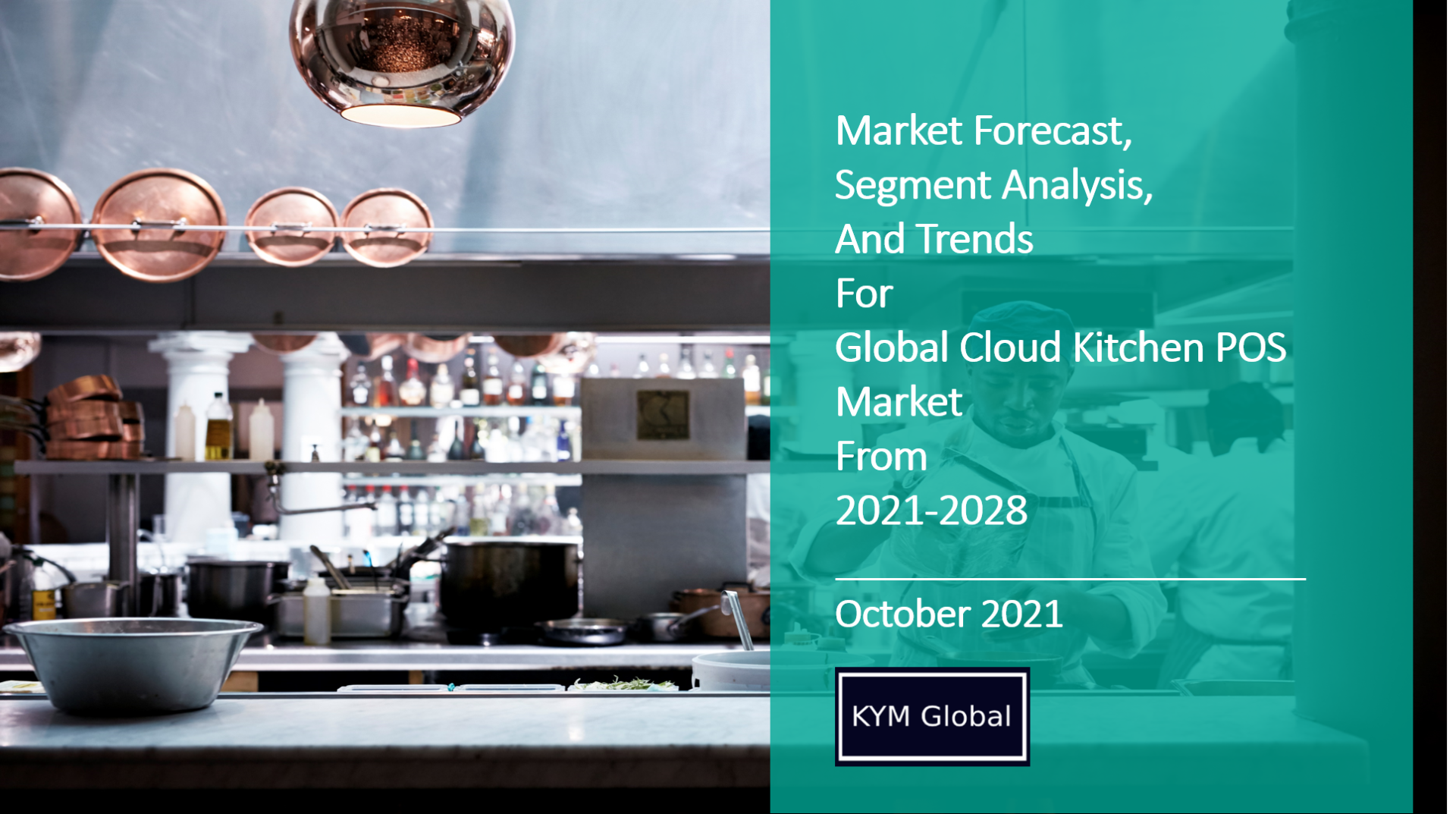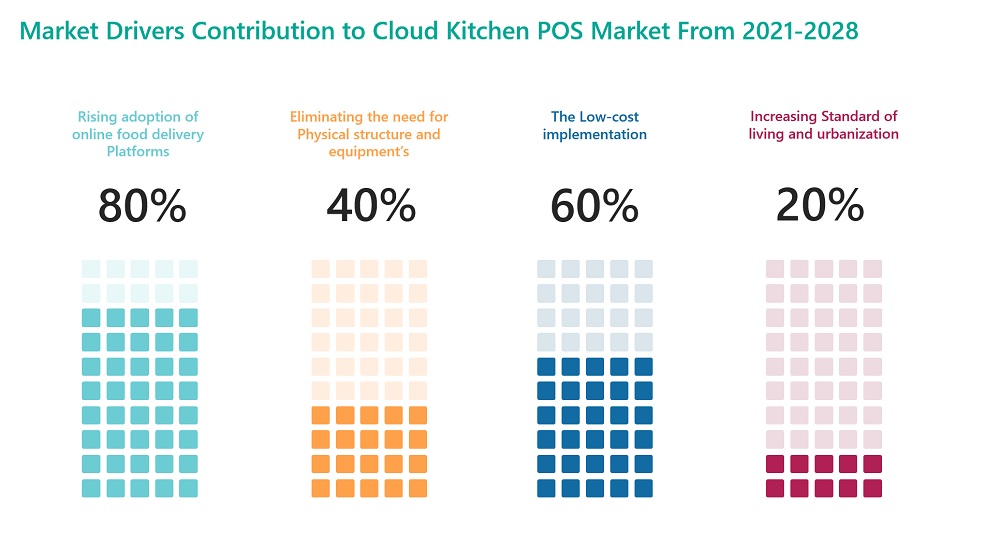
GLOBAL CLOUD KITCHEN POS MARKET
MARKET ANALYSIS & SEGMENT FORECAST FROM 2021 TO 2028Global Cloud Kitchen POS Market Size, Share & Trends Analysis Report By Components: Platform and Services, By Platform Type: Order Management, Brand Management, Inventory Management, Customer Experience Management, and Others (Marketing Management, and Reporting & Analytics), By Service Type: Consulting and Training Services, System Integration and deployment, Technical Support, and Other Managed services, By Deployment Mode: Web and Mobile, By Region: North America, Europe, Asia-Pacific, South America, and ME&A And Segment Forecasts, 2021 - 2028
Published Date: Oct 2021
Base Year for Estimate: 2020
Report ID: KYMGLIT03
Format: Electronic (PDF)
Number of Pages: 190
Price: USD 5000
Market Outlook
Market Size & Forecast (2021-2028)
Segment Analysis (2021-2028)
Market Drivers & Restraints
COVID-19 Impact Analysis
Competitive Landscape & Company Profiles
KOL Commentary (Primary Research)
Session With Analyst
The report covers the following major segments:
- By Components: Platform and Services
- By Platform Type: Order Management, Brand Management, Inventory Management, Customer Experience Management, and Others (Marketing Management, and Reporting & Analytics)
- By Service Type: Consulting and Training Services, System Integration and deployment, Technical Support, and Other Managed services
- By Deployment Mode: Web and Mobile
- By Region: North America, Europe, Asia-Pacific, South America, and ME&A
Regional Scope
The report covers five regions including North America, Europe, Asia-Pacific, South America, and ME&A. Each region is segregated by countries, which include North America (USA, Canada, Mexico), Europe (UK, Germany, France, Spain, Italy, and Rest of Europe), Asia-Pacific (India, China, Japan, and the Rest of Asia-Pacific), South America (Brazil, Rest of South America), ME&A (Middle East and Africa).
Estimates and Forecast Analysis
- Base year: 2020 || Projected years: 2021-2028
- The key industry dynamics, major technological trends, and application markets have been evaluated to understand their impact on demand for the forecast period. The growth rates were estimated using correlation, regression, and time-series analysis
- The bottom-up approach has been used for market sizing, analysing key regional markets, dynamics, and trends
- All market estimates and forecasts have been validated through primary interviews with the key industry participants
- Inflation has not been accounted for to estimate and forecast the market. Numbers may not add up due to rounding off
What is Cloud Kitchen Point-Of-Sales (POS)?
A cloud Kitchen point-of-sale (POS) system is used to integrate multiple cloud kitchens and third-party aggregators to manage data across multiple brands and outlets of the cloud kitchens. A POS system helps the cloud kitchens single-handed, from taking the order to delivering the food to the customer at right time by managing orders, brands, inventory, and customer experience.
As cloud kitchens are fully dependent on technology, tracking customer experience, managing their orders based on likings and disliking’s and providing suggestions are key growth factors for the cloud kitchen. In this case, POS manages customer experience and helps the cloud kitchens to advertise their brand on social media.
- Centralization of Orders: POS helps the customers to place the order from different cloud kitchens in one order. Immediately the information of the order is sent to the nearest cloud kitchen and ensures minimum delivery time and customer satisfaction.
- Live Data Report and Analysis: POS provides a tracking system to both the customer and cloud kitchen with live status of the food orders and real-time-location analysis of the customers.
- Monitoring Operations: The cloud kitchen operations can be done from anywhere and the operations such as last-minute recipe customization can be done using POS systems.
- Sales Management: POS software provides easy transaction, choosing of delivery partner, and food aggregators on a single screen.
- Management of various Cloud Kitchens: To avoid delays in operations and food delivery, managing all the cloud kitchen outlets is a must. With the POS systems, the kitchens will be organized better and easier for the staff to work.
- Immediate Assignment of Delivery Partner: Immediately after the delivery notification is sent to POS, the delivery partner will be notified and assigned to the respective customer.
Market Drivers

Rising adoption of online food delivery Platforms:
In recent years, the food business has seen a considerable transformation. Customers may now buy food online and have it delivered to their homes in as little as an hour. The business of bringing restaurant meals to home is rapidly changing as new online platforms compete for markets and customers all over the world. The main reason for the rising adoption of online food delivery platforms is that customers may order from a variety of eateries with a single tap of their smart phone due to online food-delivery platforms that are expanding choice and convenience. Online food delivery platforms provide choice and convenience to their consumers, which are driving the adoption of online food delivery platforms. The business of bringing restaurant meals to your home is rapidly changing as new online platforms compete for markets and customers all over the world.
The platform's adoption rate has improved as a result of Covid-19 pandemic, and the platform's user base has exploded as a result of the platform's increasing focus on hygiene and sanitation. The pandemic has taught people about the need for hygiene and clean food, as well as influence on human health. People are now more concerned about their health and the foods they consume. The cloud kitchen platform assures customers that the food they consume is clean and hygienic. Most restaurant customers prefer to eat in the comfort of their own homes at the end of a long day and the online delivery platform provides that comfort to the customer.
Major market-leading factors for the rising adoption of online food delivery platforms are:
- Convenience: Convenience is king for most people now that food can be delivered at the touch of a button from the comfort of their own home at any time of day.
- Focusing on Health: As ordering food has become more common, there is a rising desire for healthy, home-cooked meals, resulting in the advent of new business models such as cloud kitchen and meal subscriptions.
- Working Population: Rising number of the working population in the metro cities is the key attribute for the adoption of online food delivery platforms.
- Increasing Digital Behavior: As the number of people using the internet grows year after year, there is plenty of space to expand its reach, engagement, and frequency of use of Apps for food technology.
There are two types of online platforms, which include:
- Aggregators: Aggregators expand on the traditional meal delivery paradigm by allowing customers to order from many restaurants through a single internet portal. Consumers may instantly compare menus, prices, and peer ratings by logging on to the site or app. The aggregators take a certain percentage of the order that is paid by the restaurant, and the restaurant oversees the actual delivery. The consumer will not incur any further costs. Aggregators have 40% to 50% earnings before interest, taxes, depreciation, and amortization (EBITDA) margins because of their asset-light business.
- New delivery: Consumers can compare products and order meals from a group of restaurants through a single website or app, much as they can with aggregators. Importantly, the players in this sector also handle the restaurant's logistics. This enables them to provide home delivery to a previously untapped part of the restaurant market: higher-end eateries that did not previously offer it. The restaurant compensates the new-delivery players with a defined margin of the order as well as a tiny flat fee from the consumer. Despite increased maintenance costs for delivery vehicles and personnel, new-delivery players achieve EBITDA margins of above 30%.
Market Restraints
Lack of direct customer interaction:
Customers can only connect with cloud kitchens via their website or delivery app because they operate online. A delivery-only restaurant has no way of knowing what its customers think because it doesn't have a dine-in option. Furthermore, by delegating delivery services to a third-party source, dark kitchens typically relinquish control over the client experience, which could contribute to repeat business. Because the company operates remotely and it's critical to provide a human touch to expand the customer base and earn their trust. To create client connections, cloud kitchen owners are unable to speak with customers face to face to obtain true feedback. Instead, they must rely on online comments, which may or may not be genuine. Customers in a limited number owing to people who use the internet, smartphones, and applications only purchase online food, so foot traffic is low in comparison to traditional restaurants or outlets. As a result, customers are limited to some extent in every location. Non-technical people will be unable to taste the food prepared in the kitchen.
Limited brand visibility:
The cloud kitchen's brand visibility is limited because the cloud restaurant only uses an internet approach for food delivery and must rely on a third-party food aggregator for delivery. Cloud kitchen does not have the benefit of a prime location or the popularity of their brand to draw walk-in customers in that region. To attract customers, cloud kitchen must have a presence on social networking sites and other popular applications, but this advertising adds to the business's expenses. The delivery app owns the customer of cloud kitchen as their brand is more visible to the consumer. It's all about the community in a food-based business, at the end of the day. It's all about attracting repeat customers who want to try and enjoy the product. Many people travel to that unique place or restaurant to commemorate a special occasion because they have an emotional attachment to the owner or the location. In the cloud food and beverage industry, being able to build a brand and establish a connection with customers is critical.
Market Segmentation
- By Components
- Platform
- Services
- By Platform Type
- Order Management
- Brand Management
- Inventory Management
- Customer Experience Management
- Others (Marketing Management, and Reporting & Analytics)
- By Service Type
- Consulting and Training Services
- System Integration and deployment
- Technical Support
- Other Managed services
- By Deployment Mode
- Web
- Mobile
- By Region
- North America
- USA
- Canada
- Mexico
- Asia-Pacific
- China
- India
- Japan
- Rest of Asia-Pacific
- Europe
- UK
- Germany
- France
- Spain
- Italy
- Rest of Europe
- South America
- Brazil
- Rest of South America
- ME&A
- Middle East
- Africa
- North America
Company Profiles
- POSist Technologies Pvt. Ltd.
- Toast, Inc.
- Square, Inc.
- Xenial, Inc.
- Ambiosys Labs Pvt Ltd.
- ORDERLORD Inc.
- LogBase Technologies LLP
- Lightspeed HQ
- PAR Technology Corp.
- Grubtech
- GOFRUGAL Inc.
- Truffle Inc.
- Loyverse Inc.
| Report Attribute | Details |
| Market size value in 2020 | USD 1505.2 Mn |
| Revenue forecast in 2028 | USD 6317.8 Mn |
| Growth rate | CAGR of 19.6% from 2021 to 2028 |
| Base year for estimation | 2020 |
| Forecast period | 2021-2028 |
| Quantitative units | Revenue in USD million and CAGR from 2021 to 2028 |
| Report coverage | Market Size by Region, Revenue Size, Company Profiles, KOL Commentary, SWOT, Porter's Five Forces, Growth Factors, and Trends |
| Segments covered | By Components, By Platform Type, By Service Type, By Deployment Mode, By Region |
| Regional scope | Global-North America, South America, APAC, Europe, ME&A |
| Country scope | USA, Canada, Mexico, India, China, Japan, UK, Germany, France, Italy, Brazil, Middle East, Africa |
| Key companies profiled |
POSist Technologies Pvt. Ltd., Toast, Inc., Square, Inc., Xenial, Inc., Ambiosys Labs Pvt Ltd., ORDERLORD Inc., LogBase Technologies LLP, Lightspeed HQ, PAR Technology Corp., Grubtech, GOFRUGAL Inc., Truffle Inc., Loyverse Inc. |
Report Related Frequently Asked Questions?
Buy full detailed market research report to get full insights!
